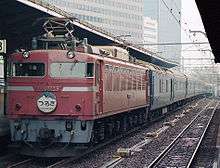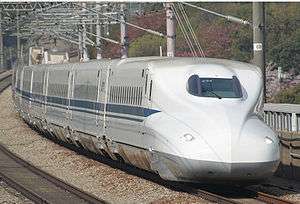Tsurugi (train)
The Tsurugi (つるぎ) is a high-speed shinkansen train service operated by West Japan Railway Company (JR West) between Toyama and Kanazawa on the Hokuriku Shinkansen line in Japan. The shinkansen service was introduced on 14 March 2015, but the name was first used for a limited express overnight "Blue Train" sleeping car train service operated by Japanese National Railways (JNR) and later by JR West from 1961 until 1994. It was named after Mount Tsurugi.
 A JR West W7 series train on the Hokuriku Shinkansen | |
| Overview | |
|---|---|
| Service type | Shinkansen |
| Status | Operational |
| Locale | Hokuriku region, Japan |
| First service | 1 October 1961 (Limited express) 14 March 2015 (Shinkansen) |
| Current operator(s) | JR West |
| Former operator(s) | JNR |
| Route | |
| Start | Toyama |
| Stops | Shin-Takaoka |
| End | Kanazawa |
| Distance travelled | 58.5 km |
| Average journey time | 23 minutes |
| Service frequency | 18 return services daily |
| Line(s) used | Hokuriku Shinkansen |
| On-board services | |
| Class(es) | Green + Ordinary |
| Technical | |
| Rolling stock | E7 series, W7 series |
| Track gauge | 1,435 mm (4 ft 8 1⁄2 in) |
| Electrification | 25 kV AC, 50/60 Hz overhead |
| Operating speed | 260 km/h (160 mph) |
Service outline
As of 15 March 2015, 18 return Tsurugi services operate daily as a shuttle between Toyama and Kanazawa, calling at Shin-Takaoka en route, typically taking 23 minutes.[1] Trains operate at a maximum speed of 260 km/h (160 mph).[1]
Rolling stock
- E7 series 12-car sets based at Nagano Depot, since 14 March 2015
- W7 series 12-car sets based at Hakusan Depot, since 14 March 2015
Tsurugi services are operated using JR East E7 series and JR West W7 series 12-car train sets based at Nagano and Hakusan depots respectively.[1]
 A JR East E7 series train on the Hokuriku Shinkansen
A JR East E7 series train on the Hokuriku Shinkansen
Formations
Tsurugi shinkansen services use 12-car JR East E7 series and JR West W7 series trainsets, formed as follows, with car 1 at the Toyama (eastern) end. Cars 1 to 7 are ordinary-class cars with 2+3 seating, car 11 is a "Green" car with 2+2 seating, and cars 8 to 10 and 12 are not available for passenger use. All cars are no-smoking.[2]
| Car No. | 1 | 2 | 3 | 4 | 5 | 6 | 7 | 8 | 9 | 10 | 11 | 12 |
|---|---|---|---|---|---|---|---|---|---|---|---|---|
| Accommodation | Non-reserved | Non-reserved | Non-reserved | Non-reserved | Reserved | Reserved | Reserved | Not in use | Not in use | Not in use | Green | Not in use |
| Facilities | Toilets | Toilets, phone | Toilets | Wheelchair space, accessible toilet, phone | Wheelchair space, accessible toilet |
History
Sleeping car Tsurugi

The Tsurugi service was first introduced on 1 October 1961 as a limited express service operating between Osaka and Niigata.[3] Regular Tsurugi services were discontinued from the start of the revised timetable on 4 December 1994.[3]
Shinkansen Tsurugi
From 14 March 2015, the name Tsurugi was reinstated for use on all-stations shuttle services operating between Toyama and Kanazawa following the opening of the Hokuriku Shinkansen beyond Nagano.[1]
References
- 長野~金沢のあらまし [Outline of Nagano to Kanazawa]. Tetsudō Daiya Jōhō Magazine (in Japanese). Vol. 44 no. 371. Japan: Kōtsū Shimbun. March 2015. pp. 12–14.
- JR Timetable. Japan: Kotsu Shimbunsha. February 2015. EAN 4910053110259.
- Teramoto, Mitsuteru (July 2001). 国鉄・JR列車名大辞典 [JNR & JR Train Name Encyclopedia]. Tokyo, Japan: Chuoshoin Publishing Co., Ltd. pp. 164–165. ISBN 4-88732-093-0.
External links
| Wikimedia Commons has media related to Tsurugi (train). |
- JR West Tsurugi train information (in Japanese)


.svg.png)